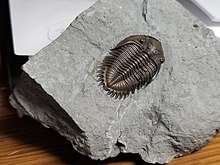Greenops
Greenops is a mid-sized Devonian trilobite of the order Phacopida, subfamily Asteropyginae. They are mainly reported from the mid-Devonian Hamilton Group of upstate New York and southwestern Ontario. A similar-looking trilobite from Morocco is often mis-labelled Greenops. Greenops had schizocroidal eyes (resembling compound eyes in insects), large genal spines and short, sharp spines at the tip of each segment of the pygidium ("tail"). Greenops lived in warm, fairly deep water. In the Hamilton Group of New York, they are found with Phacops, Dipleura and Bellacartwrightia, a trilobite that resembles Greenops but has much larger pygidial spines. In Ontario, they are found in the Widder Formation, which outcrops at Arkona, where they are, by far, the dominant trilobite.
| Greenops | |
|---|---|
 | |
| G. widderensis Widder Shale, Arkona, Ontario CA | |
| Scientific classification | |
| Kingdom: | |
| Phylum: | |
| Class: | |
| Order: | |
| Suborder: | |
| Superfamily: | |
| Family: | |
| Subfamily: | Asteropyginae |
| Genus: | Greenops[1] Delo, 1935 |
| species | |
| Synonyms | |
|
Cryphaeus Green, 1837 non Cryphaeus Klug, 1833, a Tenebrionid beetle | |
Greenops' average size is about 1 to 1.5 inches (2.5 to 3.8 cm). They were fairly common trilobites, and are easily identified. While it is rare to find a complete disarticulated body, segments and tails are fairly common. They are fairly common finds in Late Devonian limestones, especially storm deposits. They are identified by their tails, which sport several spines. They were medium to small sized trilobites, which were most likely preyed upon by ammonoids, straight cephalopods, sharks, and small placoderms, hence the defensive spines. All of these animals have been found in close association with this trilobite. Greenops can also be found in deep marine deposits, but there it is fairly rare. Greenops was a small, yet charmingly beautiful trilobite, like its close companion Phacops.
Taxonomy
Species previously assigned to Greenops
Some species originally described under this genus have since been reassigned to other genera.[1]
- G. alpensis = Kayserops alpensis
- G. arkonensis = Stummiana arkonensis
- G. chaconae = Breizhops chaconae
- G. haasi = Deloops haasi
- G. osismorum = Stummiana osismorum
- G. pleione = Bellacartwrightia pleione
- G. stellifer = Neometacantus stellifer
- G. struvei = Modellops struvei
- G. transversensis = Kayserops transversensis
Distribution
Fossils of Greenops have been found in France, the Floresta Formation of the Altiplano Cundiboyacense, Colombia,[2] Libya, Spain, United States (Illinois, Indiana, Iowa, New York, Pennsylvania), Canada (Arkona,Ontario) and the Caño del Oeste Formation of Venezuela.[3]
References
- Lieberman, B.S.; Kloc, G.J. (1997). "Evolutionary and biogeographical patterns in the Asteropyginae (Trilobita, Devonian) Delo, 1935". Bulletin of the American Museum of Natural History. 232. Retrieved 16 December 2013.
- Morzadec et al., 2015, p.348
- Greenops at Fossilworks.org
Bibliography
- Morzadec, Pierre; Michal Mergl; Carlos Villarroel; Philippe Janvier, and Patrick R. Racheboeuf. 2015. Trilobites and inarticulate brachiopods from the Devonian Floresta Formation of Colombia: a review. Bulletin of Geosciences 90. 331-358. Accessed 2017-04-04.
Further reading
- Ludvigsen, Rolf, Fossils of Ontario, Part 1: The Trilobites. Toronto: Royal Ontario Museum Press, 1983